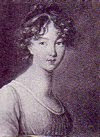
La Tricoteuse, c 1816
Madame G. Busset-Dubruste, (fl. 1806-17( (attributed to)
French
Coloured engraving (by Duthe)
Private collection; the Stapleton Collection
Source: The Bridgeman Art Library
Image ID: STC 428338
I have not posted many projects lately but that is because so many are in progress. I do suffer greatly from Startitis but I have also been slowly finishing off my 2011 list of Things to Make. This list was more about Things to Finish since I took a private oath last January to have no WIPs on my Ravelry page by December 31, 2011 and a finished stack of quilts that are WIPs accumulated over the last twenty years.

The Dressmaker
Fernando Botero (b. 1932)
Colombian
Medium (unknown)
Private Collection
(Photograph: Copyright Christie’s Images)
Source: The Bridgeman Art Library
Image ID: CH 27259
Hand, arm, shoulder and neck pain has considerably cut down on my quilting progress (I do every stage by hand), and I have also been doing more Irish stitch canvas and crewel work and embroidery these days. The historic wardrobe needs some replenishing, too, and a few doll beds are calling for new linens with knitted edges. Other knitting includes the shawl for the neighbour, the three green garments and that short quasi-cloak for me, buttons for The Garment, seven or eight historical items etc, etc. – hmmmm, I think I need to cancel that oath.

Games, 1939
Charles Walch (1898-1948)
French
Oil on canvas
Musee d’Art Moderne de la Ville de Paris
Source: The Bridgeman Art Library
Image ID: XIR 209962
Although I truly do have some sort of sewing/needlework/knitting needle in my hands every day, my output can be frustrated when Life interferes, with or without warning.

Girl Knitting
John Parker (1839-1915)
English
Watercolour on paper
Private collection
Source: The Bridgeman Art Library
Image ID: BAL 19343
I seize every opportunity to work on projects, knitting being the most portable. I love to go to the nearby beach and parks and work in the open air and pure daylight. Stretching my eyesight, looking far into the distance, is also therapeutic, particularly as my profession, as well as my interests, requires a good deal of close work.

The Felixstowe to Ipswich Coach, c. 1939
Russell Sidney Reeve (1895-1970)
English
Oil on canvas
Ipswich Borough Council Museums and Galleries
Source: The Bridgeman Art Library
Image ID: IPS 72921
Public transport often allows for an hour’s catching up, giving me an excuse to indulge my passion for those extremely portable projects, namely socks and fingerless gloves or even that lovely green linen cardigan I have been trying to finish since the spring.

Best of Friends
Emile Munier (1810-?)
French
Medium (unknown)
Private collection
(Photograph: Copyright Christie’s Images)
Source: The Bridgeman Art Library
Image ID: CH 27496
Back at home or visiting with friends, there is often well-meaning canine/feline assistance that then changes into sitting on the project or my lap which slows down progress.

The Concert
Georg Jacobides (1853-1932
Greek
Medium (unknown)
Private Collection
(Photograph: Copyright Christie’s Images)
Source: The Bridgeman Art Collection
Image ID: CH 27091
And the other kind of domestic interruption.

The Veranda at Villerville
Raoul Dufy (1877-1953)
French
Oil on canvas
Musee des Beaux-Arts Andre Malraux
Le Havre, France
Source: The Bridgeman Art Library
Image ID: XEH 53834
Lunch-time at work, with fellow-enthusiasts, lets me to catch up with simple projects such as charity knitting, that I can work on, and chat and eat, all at the same time – more or less!

A Girl Reading
Charles Edward Wilson (1853-1941)
English
Watercolour and gouache on paper
Private collection
(Photograph: The Mass Gallery, London)
Source: The Bridgeman Art Library
Image ID: MAA 80673
Research into all aspects of historical textiles (and paintings with knitting, like these) never ends and that takes up hours and hours of non-stitching time.

These are some of my recent choices.

Popular Wireless, 3 June 1922
(front cover)
English
Colour lithograph
Private collection
Source: The Bridgeman Art Library
Image ID: XCF 307304
My favourite way of working on just about anything is in the company of the radio. Thanks to the internet, I can listen to stations from all over the world and can be entertained, educated, and kept alert and productive, twenty-four hours a day.

The Cottage Door (1866)
Henry Bright (1810-1873)
English
Oil on canvas
York Museums Trust (York Art Gallery)
Source: The Bridgeman Art Library
Image ID: YAG 23480
So I shall continue to chip away at that List, hoping to knit and stitch and sew outdoors for a few weeks more, enjoying my favourite season of all – autumn with all of its glorious greens, oranges, bronzes, golds, browns, reds!


























